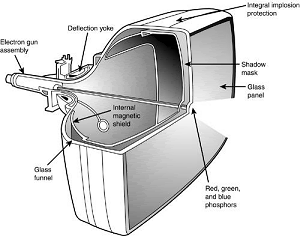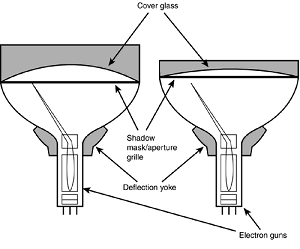How CRT Display Technology Works
A monitor can use one of several display technologies. The original display technology, and still the most popular, is cathode ray tube (CRT) technology—the same technology used in television sets. CRTs consist of a vacuum tube enclosed in glass.
One end of the tube contains an electron gun assembly that projects three electron beams, one each for the red, green, and blue phosphors used to create the colors you see onscreen; the other end contains a screen with a phosphorous coating.
When heated, the electron gun emits a stream of high-speed electrons that are attracted to the other end of the tube. Along the way, a focus control and deflection coil steer the beam to a specific point on the phosphorous screen. When struck by the beam, the phosphor glows. This light is what you see when you watch TV or look at your computer screen.
Three layers of phosphors are used: red, green, and blue. A metal plate called a shadow mask is used to align the electron beams; it has slots or holes that divide the red, green, and blue phosphors into groups of three (one of each color). Various types of shadow masks affect picture quality, and the distance between each group of three (the dot pitch) affects picture sharpness.

The phosphor chemical has a quality called persistence, which indicates how long this glow remains onscreen. Persistence is what causes a faint image to remain on your TV screen for a few seconds after you turn the set off. The scanning frequency of the display specifies how often the image is refreshed.
You should have a good match between persistence and scanning frequency so the image has less flicker (which occurs when the persistence is too low) and no ghost images (which occurs when the persistence is too high).
The electron beam moves very quickly, sweeping the screen from left to right in lines from top to bottom, in a pattern called a raster. The horizontal scan rate refers to the speed at which the electron beam moves laterally across the screen.
During its sweep, the beam strikes the phosphor wherever an image should appear onscreen. The beam also varies in intensity to produce different levels of brightness. Because the glow begins to fade almost immediately, the electron beam must continue to sweep the screen to maintain an image—a practice called redrawing or refreshing the screen.
Most current CRT displays have an ideal refresh rate (also called the vertical scan frequency) of about 85 hertz (Hz), which means the screen is refreshed 85 times per second. Refresh rates that are too low cause the screen to flicker, contributing to eyestrain.
The higher the refresh rate, the better for your eyes. Low-cost monitors often have flicker-free refresh rates available only at 640x480 and 800x600 resolutions; you should insist on high refresh rates at resolutions such as 1024x768 or higher. It is important that the refresh rates expected by your monitor match those produced by your video card.
If you have mismatched rates, you will not see an image and can actually damage your monitor. Generally speaking, video card refresh rates cover a higher range than most monitors. For this reason, the default refresh rate used by most video cards is relatively low (usually 60Hz) to avoid monitor damage. The refresh rate can be adjusted through the Windows display properties sheets.
Multiple Frequency Monitors
Although a few very old monitors had fixed refresh rates, most monitors support a range of frequencies. This support provides built-in compatibility with a wide range of current and future video standards. A monitor that supports many video standards is called a multiple-frequency monitor.
Virtually all monitors sold today are multiple frequency, which means they support operation with a variety of popular video signal standards. Different vendors call their multiple-frequency monitors by different trade names, including multisync, multifrequency, multiscan, autosynchronous, and autotracking.
Curved Versus Flat Picture Tubes
Phosphor-based screens come in two styles: curved and flat. Until recently, the typical display screen has been curved; it bulges outward from the middle of the screen. This design is consistent with the vast majority of CRT designs (the same as the tube in most television sets).
Although this type of CRT is inexpensive to produce, the curved surface can cause distortion and glare, especially when used in a brightly lit room. Some vendors use antiglare treatments to reduce the reflectivity of the typical curved CRT surface.
The traditional screen is curved both vertically and horizontally. Some monitor models use the Sony Trinitron CRT, some versions of which are curved only horizontally and flat vertically; these are referred to as flat square tube (FST) designs.
Most manufacturers are now selling monitors featuring CRTs that are flat both horizontally and vertically. Sony's FD Trinitron, NEC-Mitsubishi's DiamondTron NF, and ViewSonic's PerfectFlat are some of the more popular flat CRT designs, the first such screens for PCs since the short-lived Zenith FTM monitors of the late 1980s.
Many people prefer this type of flatter screen because these picture tubes show less glare and provide a higher-quality, more accurate image. Although flat-screen CRTs are slightly more expensive than conventional curved CRTs, they are only one-third to one-half the price of comparably sized flat-panel LCD displays. Figure below compares the cross-section of typical curved and flat CRT picture tubes.
